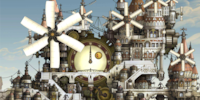
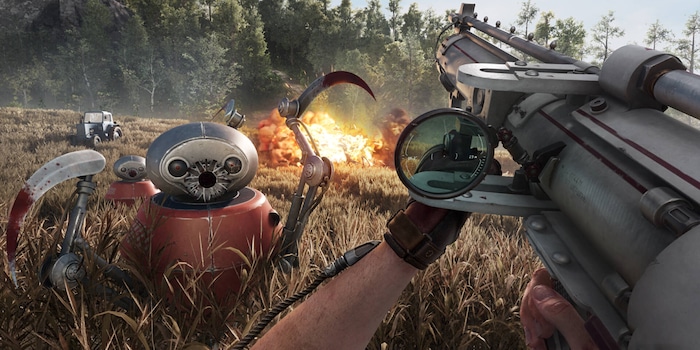
Trying out Atomic Heart – a monumental game with a monumental bonehead
Atomic Heart certainly isn’t lacking in ambition. Its alternate universe centred around a futuristic Soviet Union is bursting with ideas – in gameplay and design. It’s a shame the story’s so flimsy and the main character’s an absolute jerk.
Sergey Nechaev is a Soviet special agent and grade A asshole. He makes Duke Nukem look like the world’s most charming gentleman. Now, none of this would be a problem if Sergey wasn’t the main character of Atomic Heart and I wasn’t forced to listen to his constant grumbling. I can’t remember ever playing a more unlikable character. Even though the digital art book in the main menu gives me some backstory on Sergey’s character, I find him unbearable as ever after 10 hours of play. A pity, because Atomic Heart does offer a lot worth experiencing.
The bonehead and the boring story
The story is set in a fictional universe in 1955 where the Soviet Union has grown into a futuristic superpower. Thanks to a technology called Polymer, the USSR has developed a networked artificial intelligence of high-tech robots. Polymer even allows humans to connect to this neural network, the «Kollektiv 2.0». You don’t need to have seen Terminator to know what comes next. The robots turn on their creators and plunge the Facility 3826 test site, where Polymer is being tested, into bloody chaos. Who’s expected to fix things? Who else than super soldier and crank Sergey Nechaev.
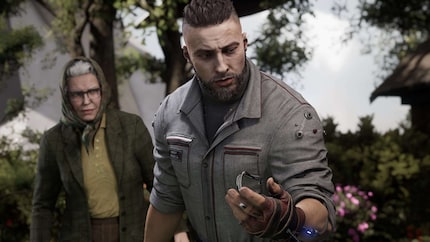
Although the idea of rebelling robots is old hat, the retro-future setting definitely has potential. It feels like a Soviet version of Fallout. Unfortunately, the story’s barely picked up any momentum and seems completely predictable so far. I could live with that if Sergey wasn’t such an arse. From the very first minute, he comes off as a cocky, condescending, line-toeing bootlicker. And because he has a compulsive need to communicate his every thought, I feel like the warmongering bastard’s poorly paid therapist. Sorry, his tone of voice is contagious ...
By now, I’ve become somewhat accustomed to the tantrums, though they’ve yet to become entertaining or amusing. The language option you go for certainly plays a part. After trying to play in German, I switched to English. The German version was unbearable and sounded even worse. The best version I tried out was Russian, but reading the subtitles while shooting proved a bit too much of a hassle. Fortunately, the second prominent voice in the game is much more civilised. It belongs to Charles, an artificial intelligence that lives in Sergey’s polymer cyber glove. His special skills include explanations lasting several minutes to keep the story moving forward. Fret not, it gets better from here on out.
A brave new world
Atomic Heart looks like a 1950s concept artist’s dream come true – from the countless robots (which are surprisingly athletic) to the design of the high-tech research facilities. The underground laboratories in particular are full of mysterious machines and experiments. I’ll find myself wandering through a kind of museum with floating, fluorescent robotic whales, and then I’ll enter a hall full of droning orange generators that glow. The world created by Studio Mundfish is fascinating. Side note: unfortunately, I simply don’t have the time to go into detail about the current controversy regarding Mundfish. In a nutshell, the studio has made negative headlines with its statements on the war between Russia and Ukraine and possible data sharing with Russian authorities.
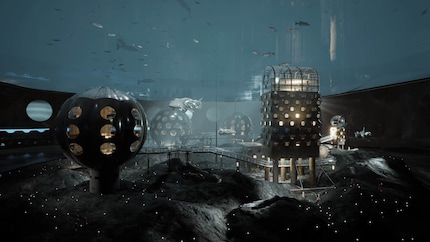
Back to Atomic Heart. Sergey must fight his way through hordes of crazed robots to find the saboteurs behind the chaos and prevent the USSR’s reputation from being tarnished. Tough luck for Sergey, as all the household and work robots happen to be excellent killing machines.
Action that’ll make you break a sweat
Fighting against the colourful arsenal of robots running amok makes up a large part of the game. Fortunately, Atomic Heart provides me with plenty of murder weapons. By searching through cabinets, crates and killed enemies, I collect resources to build or upgrade them. Coupled with the game’s saving system – you can only save at certain locations – Atomic Heart has some characteristics of a survival game.
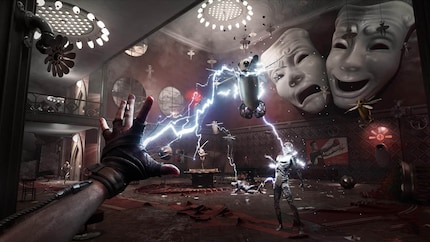
From special attacks to cartridges that cause elemental damage, you have a variety of combat options. In addition, there’s the cyber glove. Similar to Bioshock, you can use it to throw out thunderbolts or freeze robots. The weapons and the glove provide a lot of variety in fights. And there are quite a few fights. The flying, jumping and rolling robots get me sweating on a regular basis, especially because there are annoying flying repair robots that just go ahead and fix up your defeated enemies. The only strategy I’ve found against this so far is as follows: I overload a huge drone named Hawk from a control centre I previously got into through a hacked surveillance camera and then make an emergency landing. All machines in the vicinity remain deactivated until the drone is repaired. This is simultaneously relaxing and eerie; the world feels even more deserted.
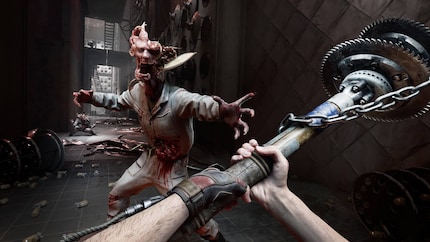
The misguided household robots are no match compared to the bosses, though. One of the first epic battles is against a round steel colossus who swings his arms through the air like morning stars, shoots rings of fire around himself and seeks to take my life like a wrecking ball. As if that wasn’t action enough, the fight is accompanied by a groovy metal soundtrack penned by Mick Gordon (Doom). It’s amazing. And when I’m not turning robots into scrap iron in Atomic Heart? Why, then I’m solving puzzles.
Lockpicking puzzles: a case of déjà vu
Why are there so many fucking lockpicking puzzles?! That’s not my frustration I’m venting, by the way. It’s Sergey’s. Virtually every time he’s confronted by a locked door or a mechanism requiring multiple parts to work, a rant follows. Granted, there are definitely a lot of lockpicking puzzles and collection tasks in Atomic Heart. But if there’s anything I hate more than stale game mechanics, it’s games that make fun of their own lack of ideas. In the case of Atomic Heart, however, I have to say that the puzzles are at least original in design. There are locks you open using sound and by snapping your fingers at the right moment. There are also rooms with giant magnets where you can reverse the poles to pass through. It even gives off some Portal-esque vibes.
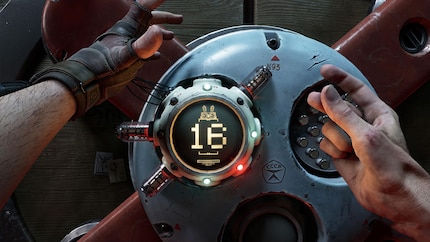
There are other smaller puzzles at optional test sites, which are separate dungeons similar to the bunkers in Fallout. There, you find valuable resources as well as blueprints for important weapon upgrades. The game only tells you the approximate location, but not how to get in. Sometimes the door can be hacked by camera, other times you have to track underground connections with the scanner to short-circuit generators again by camera hack. But because the outside world is littered with robots and their repair services, it’s pretty stressful.
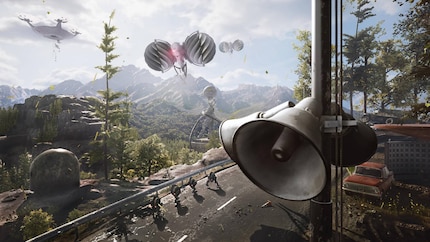
What to make of this?
I’m finding it surprisingly difficult to give a clear verdict on Atomic Heart. Assuming I continue to focus on the main story, I’m about two thirds of the way through the game. The world and design of Atomic Heart are terrific. From the robots to the mysterious research facilities, I’m treated to things I’ve never seen before. I’d love to scout out all the test sites to find out what other crazy stuff these scientists have come up with. The game offers a lot to discover. I can’t complain about its vastness.
On the other hand, Atomic Heart also features a so far irrelevant story with some miserable acting. This doesn’t necessarily apply to the main character; Sergey’s supposed to be unlikeable. The fact that he really is could be deemed a success. Unfortunately, listening to him just isn’t fun. Either way, I’m excited to see where the game takes me.
Atomic Heart is available on PC, PS4, PS5, Xbox One, Xbox Series. The game was provided to me by Plaion.
Being the game and gadget geek that I am, working at digitec and Galaxus makes me feel like a kid in a candy shop – but it does take its toll on my wallet. I enjoy tinkering with my PC in Tim Taylor fashion and talking about games on my podcast http://www.onemorelevel.ch. To satisfy my need for speed, I get on my full suspension mountain bike and set out to find some nice trails. My thirst for culture is quenched by deep conversations over a couple of cold ones at the mostly frustrating games of FC Winterthur.


